Lviv
| L’viv Львів |
|||
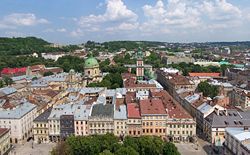 |
|||
|
|||
| Motto: "Semper fidelis" | |||
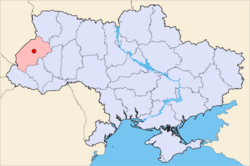 |
|||
| Coordinates: | |||
| Country | |||
|---|---|---|---|
| Oblast | |||
| Raion | Lviv City Municipality | ||
| Founded | 13th century | ||
| Magdeburg law | 1353 | ||
| Government | |||
| - City Chairman | Andriy Sadovyi | ||
| Area | |||
| - City | 171.01 km² (66 sq mi) | ||
| Elevation | 296 m (971 ft) | ||
| Population (2007) | |||
| - City | 735,000 | ||
| - Density | 4,298/km² (11,131.8/sq mi) | ||
| - Metro | 1,040,000 | ||
| Time zone | EET (UTC+2) | ||
| - Summer (DST) | EEST (UTC+3) | ||
| Postal code | 79000 | ||
| Area code(s) | +380 32(2) | ||
| Licence plate | BC (before 2004: ТА,ТВ,ТН,ТС) | ||
| Sister cities | Corning, Freiburg, Kraków, Novi Sad, Przemyśl, Whitstable, Winnipeg | ||
| Website: http://www.city-adm.lviv.ua | |||
Lviv (Ukrainian: ![]() Львів, L’viv [ljviw], Polish: Lwów; German: Lemberg; Lithuanian: Lvovas; Russian: Львов, L'vov; see also other names) is a major city in western Ukraine.
Львів, L’viv [ljviw], Polish: Lwów; German: Lemberg; Lithuanian: Lvovas; Russian: Львов, L'vov; see also other names) is a major city in western Ukraine.
It is regarded as one of the main cultural centres of Ukraine. In 2001, it had 725,000 inhabitants, of whom 88 per cent were Ukrainians, 9 per cent Russians (down from 16 percent in 1989) and 1 per cent Poles.[1] A further 200,000 people commuted daily from suburbs.
The city has many industries and institutions of higher education such as the Lviv University and the Lviv Polytechnic. It has a philharmonic orchestra and The Lviv Theatre of Opera and Ballet. The historic city centre is on the UNESCO World Heritage List. Lviv celebrated its 750th anniversary with a son et lumière in the city centre in September 2006.
For many centuries it was contested: first it belonged to the Kievan Rus', since 1340 to the Kingdom of Poland, and subsequently to the Polish half of the Commonwealth. In 1772 it became part of Austria, and after the downfall of the Austro-Hungarian Empire in World War I, the city belonged to the Second Polish Republic. As a result of the joint Nazi-Soviet attack on Poland, Lviv was taken by the USSR. Now, it belongs to the independent Ukraine.
In 1772, following the First Partition of the Polish-Lithuanian Commonwealth, the city, known in German as Lemberg, became the capital of the Austrian Kingdom of Galicia and Lodomeria. After Poland was reconstituted following World War I, Lviv was the centre of ethnic-political controversy and tension between nationalistic Austro-Germans, Poles, Jews, and Ukranians, for a short time becoming the capital of the Western Ukrainian Republic, eventually it was conquered by the newly reestablished Poland. After World War II Poland's borders were relocated generally towards the west and the city fell to the Soviet Union. After the collapse of the U.S.S.R. it became part of the newly independent Ukraine—for which it currently serves as the administrative centre of Lviv Oblast, and designated as its own raion (district) within that oblast.
Contents[hide] |
Geography
Location
Lviv is on the edge of the Roztochia Upland, about 70 km from the Polish border and about 160 km (100 miles) from the eastern Carpathian Mountains. The average altitude of Lviv is 296 m above sea level, although it has many hills. Its highest point is the Vysokyi Zamok (High Castle), 409 m above sea level. This has a commanding view of the historic city centre with its distinctive green-domed churches and intricate architecture.
The old walled city was at the foothills of the High Castle on the banks of the river Poltva. In the 13th century, the river was used to transport goods. In the early 20th century, it was covered over in areas where it flows through the city. The river flows directly beneath the central street of Lviv, Freedom Avenue (Prospect Svobody) and the famous Opera House.
Climate
Lviv's climate is moderate continental. The average temperatures are −4°C (27°F) in January and +20°C (65 °F) in June. Average annual rainfall is 660 mm (26 inches), with a maximum in summer. Cloud coverage averages 66 days per year.
History
Lviv was founded by King Danylo Halytskiy of the Ruthenian principality of Halych-Volhynia, and named in honor of his son, Lev. When Danylo died Lev made Lviv the capital of Halich-Volhynia. The city is first mentioned in the Halych-Volhynian Chronicle,which dates from 1256. It was captured by Poland in 1340 and, in 1356, Casimir III of Poland brought in German burghers and granted the Magdeburg rights which implied that all city matters were to be resolved by a council, elected by the wealthy citizens. The city council seal of the 14th century stated: S(igillum): Civitatis Lembvrgensis. As part of Poland (and later the Polish-Lithuanian Commonwealth), Lviv became the capital of the Ruthenian Voivodeship.
As Lviv prospered, it became religiously and ethnically diverse. The 17th century brought invading armies of Swedes, Hungarians from Transylvania, Russians and Cossacks to its gates. However, Lviv was the only major city of Poland that was not captured by the invaders. In 1672 it was besieged by the Ottomans, who also failed to conquer it. Lviv was captured for the first time by a foreign army in 1704, when Swedish troops under King Charles XII entered the city after a siege.
In 1772, following the First Partition of Poland, the city known in German as Lemberg became the capital of the Austro-Hungarian Kingdom of Galicia and Lodomeria. It was captured by the Russian army in September 1914 but retaken by Austria-Hungary in June the following year.
With the collapse of the Habsburg Empire at the end of World War I Lviv became an arena of conflict between the local Ukrainian and Polish-Jewish populations. During these fights an important role was taken by young Polish city defenders called Lwów Eaglets. Soon afterward, Lviv was attacked by the Red Army under the command of Aleksandr Yegorov and Stalin during Polish-Soviet War, but the city resisted[2]. For the courage of its inhabitants Lviv was awarded the Virtuti Militari cross by Józef Piłsudski on 22 November 1920.
Between the World Wars, it was the third largest Polish city (after Warsaw and Łódź) and the seat of the Lwów Voivodeship with a large Jewish population. Pogroms and repression had (save for isolated incidents) always been worse in countries outside of Poland, so cities like Lviv grew through Jewish immigration that was spurred by prejudices and repression in other countries.
In the Soviet invasion of Poland (1939), the Soviet Union took Lviv, which became the capital of the Lviv Oblast. But in the initial stage of Operation Barbarossa (late June, 1941), Lviv was taken by the Germans. This was a period of massacres in Galicia. The evacuating Soviets decided to kill the mass of people waiting in the prisons for deportation to the Gulag even if their fault was petty crimes or no fault at all. When the Wehrmacht forces arrived in the area, they discovered the evidence of the mass murders committed by the NKVD and NKGB, including the mass killing of Jews and Polish intelligentsia.
On June 30, 1941, Yaroslav Stetsko declared in Lviv the Government of an independent Ukraine. This was done without approval of the Germans, and Galicia was subsequently incorporated into the General Government as Distrikt Galizien. As Germany viewed Galicia as already aryanized and civilized, the non-Jewish Galicians escaped the full extent of German intentions more than many other Ukrainians who lived further eastward. Despite the more lenient extent of German control over the majority of the Galician population, the Jewish Galicians were deported to concentration camps, much like elsewhere in Ukraine.
The Soviets retook Lviv in the Lvov–Sandomierz Offensive of July, 1944.
Lviv and its population suffered greatly from the two world wars as the wars were fought across the local geography causing major collateral damage and disruption. Because of immigration in part, it recovered somewhat faster between the wars than comparable cities. World War II also brought the deliberate murders of the Holocaust. After the war, the Soviet Union expelled most of the ethnic Polish population, which was resettled in the Recovered Territories. Little remains of Polish culture in Lviv except for the Italian-influenced architecture[3]. The Polish history of Lwów is still well remembered in Poland.
Lviv remains today one of the main centres of Ukrainian culture, and the origin of much of the nation's political class.
Government

Administrative division
Lviv is divided into six raions (districts), each with its own administrative bodies:
- Halytskyi (Галицький район)
- Zaliznychnyi (Залізничний район)
- Lychakivskyi (Личаківський район)
- Sykhivskyi (Сихівський район)
- Frankivskyi (Франківський район)
- Shevchenkivskyi (Шевченківський район)
Notable suburbs include:
- Vynnyky (місто Винники)
- Briukhovychi (селище Брюховичі)
- Rudne (селище Рудне)
Transport

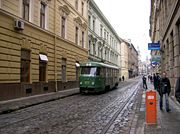

Buses
The public bus network is represented by mini-buses. They are called marshrutki, and they go all over the city. Marshrutki have no fixed stops or timetable but are cheap and fast. This kind of transport is so popular and convenient that mini-buses are often overcrowded during rush-hours. The marshrutki also run on suburban lines to most suburbs and nearby towns, e.g. to Shehyni at the Polish border. The price of a ride in marshrutka within the city is 1.50 UAH (September 2008) not depending on a distance.
Tramways
The first tramway lines were opened on 5 May 1880 and the last horse-powered line was electrified on 31 May 1894. In 1922 the tramways were switched to driving on the right-hand side. After World War II and the annexation of the city by the Soviet Union, several lines were closed but most of infrastructure was preserved. The tracks are narrow-gauge, unusual for the Soviet Union, but explained by the fact that the system was built while the city was part of the Austro-Hungarian Empire and needs to run on narrow medieval streets in the centre of town.
The Lviv tramway now runs about 220 cars on 75 km of track, most of which is in very poor condition. The trams are in fair condition but can be very full during rush hours.
Trolleybuses
After the war and expulsion of most of the population, the city grew rapidly, due to evacuees returning from Russia and the Soviet Government's vigorous development of heavy industry. This included transfer of entire factories from the Urals and other distant places to the newly "liberated" (acquired) territories of the USSR, including Lviv.
The city centre tramway lines were replaced with trolleybuses on 27 November 1952. Later, new lines were opened to the blocks of flats at the city outskirts. The network now runs 200 trolleybuses, mostly of the 1980s 14Tr type. In 2006-2008 10 modern low-floor trolleybuses built by the Lviv Bus Factory were purchased.
Railways
Modern Lviv remains a hub on which nine railways converge, providing local and international services. Lviv railway is one of the oldest in Ukraine. The first train arrived to Lviv arrived on November 4, 1861. The building of the main Lviv Railway Station was bilt in 1904 and was considered one of the best in Europe from the architectural and from the technical aspect as well. Several trains cross the nearby Polish-Ukrainian border (mostly via Przemyśl). There are good connections to Slovakia (Košice) and Hungary (Budapest). Many routes have overnight trains with sleeping compartments. Lviv railway is often called a main gateway from Ukraine to Europe.
Airport
Lviv International Airport (LWO)[4] is 6 km from the city centre.
Culture
| L’viv - the Ensemble of the Historic Centre* | |
|---|---|
| UNESCO World Heritage Site | |
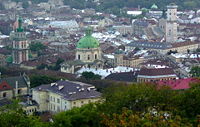 |
|
| State Party | |
| Type | Cultural |
| Criteria | ii, v |
| Reference | 865 |
| Region** | Europe and North America |
| Inscription history | |
| Inscription | 1998 (22nd Session) |
| * Name as inscribed on World Heritage List. ** Region as classified by UNESCO. |
|
Lviv's historic centre has been on the United Nations Educational, Scientific and Cultural Organization (UNESCO) World Heritage list since 1998. UNESCO gave the following reasons[5] for its selection:
Criterion II: In its urban fabric and its architecture, Lviv is an outstanding example of the fusion of the architectural and artistic traditions of eastern Europe with those of Italy and Germany.
Criterion V: The political and commercial role of Lviv attracted to it a number of ethnic groups with different cultural and religious traditions, who established separate yet interdependent communities within the city, evidence for which is still discernible in the modern townscape.
Architecture
Lviv's historic churches, synagogues, buildings and relics date from the 13th century. In recent centuries, it was spared some of the invasions and wars that destroyed other Ukrainian cities. Its architecture reflects various European styles and periods. After the fires of 1527 and 1556 Lviv lost most of its gothic-style buildings, but it retains many buildings in renaissance, baroque, and classic styles. There are works by artists of the Vienna Secession, Art Nouveau, and Art Deco styles.
The buildings have many stone sculptures and carvings, particularly on large doors, hundreds of years old. The remains of old churches dot the central cityscape. Some three- to five-storey buildings have hidden inner courtyards and grottoes in various states of repair. Some cemeteries are of interest, for example the Lychakivskiy Cemetery, where Polish elites were buried by centuries. Leaving the central area, the architectural style changes radically as Soviet-era high-rise blocks dominate. In the centre, the Soviet era is reflected mainly in a few modern-style national monuments and sculptures.
Monuments in Lviv


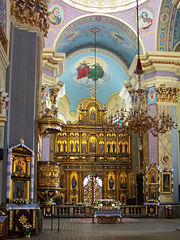


City sculptures commemorate many people and topics reflecting the rich history of Lviv. There are monuments to:
- Nikifor
- The Good Soldier Švejk
- Adam Mickiewicz
- Ivan Pidkova
- Taras Shevchenko
- Ivan Trush
- Pope John Paul II
- Jan Kiliński
- Ivan Franko
- King Danylo
- Saint George
- Mykhailo Hrushevskyi
- Bartosz Głowacki
- Monument to the Virgin Mary
- Ivan Fedorov
Books
Every day the book market takes places around the monument to Ivan Fedorov. He was a Russian typographer in the 16th century who fled Moscow and found a new home in Lviv. New ideas came to Lviv during the Austro-Hungarian Empire. In the 19th century, many publishing houses, newspapers and magazines were established. Diverse literature written in Lviv contributed to Austrian, Ukrainian, Yiddish and Polish literature. Translation work took place between these diverse cultures, creating a truly unique European culture that transcended borders. The annual Lviv Book Fair continues this tradition.
Religion
From its establishment Lemberg was a city of religious variety and conflicts between different faiths. At one point over 60 churches existed in the city. The largest Christian churches have existed in the city since the 13th century. The three major Christian groups (the Ukrainian Catholic Archeparchy of Lviv, the German-speaking and Polish Catholics, and the Armenian Church) have each had a diocesan seat in Lviv since the 16th century. In the 1700s the Orthodox community took their allegiance to the Pope in Rome and became the Ukrainian Greek Catholic Church. This bond was forcibly dissolved in 1946 by the Soviet authorities, while the Roman Catholic community was forced out by the expulsion of the Polish population. Since 1989 religious life in Lviv has experienced a revival.
Lviv is the seat of the Roman Catholic Archdiocese of Lviv, the centre of the Roman Catholic Church in Ukraine and (until 21 August 2005) was the centre of the Ukrainian Greek Catholic Church. About 35 per cent of religious buildings belong to the Ukrainian Greek Catholic Church, 11.5 per cent to the Ukrainian Autocephalous Orthodox Church, 9 per cent to the Ukrainian Orthodox Church - Kiev Patriarchate and 6 per cent to the Roman Catholic Church.
Until 2005 Lviv was the only city with two Cardinals: Lubomyr Husar (UGCC) and Marian Jaworski (RCC).
In June 2001 Pope John Paul II visited the Latin Cathedral, St. George's Cathedral, and the Armenian Cathedral.
Lviv historically had a large and active Jewish community, as witnessed today by its synagogues. Until 1941 at least 45 synagogues and prayer houses existed. Even in the 16th century, two separate communities existed. One lived in today's old town, the other one in the Krakowskie Przedmieście. In the 19th century a more differentiated community started to spread out. Liberal Jews sought more cultural assimilation and spoke German and Polish. On the other hand, Orthodox and Hasidic Jews tried to retain the old traditions. Between 1941 and 1944 the Nazis in effect completely destroyed the centuries-old Jewish tradition of Lviv. Most synagogues were destroyed, the Jewish population forced into a ghetto, from which they were later transported into concentration camps where they were murdered.[6]
Under the Soviet Union synagogues remained closed and were used as storage facilities or movie houses. Only since the fall of the Iron Curtain has the remainder of the Jewish community experienced a faint revival.
Arts
The "Group Artes" was a young movement founded in 1929. Many of the artists studied in Paris and had travelled throughout in Europe. They worked and experimented in different areas of modern art: Futurism, Cubism, New Objectivity and Surrealism. A lot of cooperation took place between avant-garde musicians and authors. Altogether thirteen exhibitions by Artes took place in Warsaw, Kraków, Łódz and Lviv. The Nazi occupation put an end to this group. Otto Hahn was executed in 1942 in Lviv, Aleksander Riemer murdered in 1943 in Auschwitz. Henryk Streng and Margit Reich-Sielska were able to escape the Shoah. Most of the surviving members of Artes lived in Poland after 1945. Only Margit Reich-Sielska (1900–1980) and Roman Sielksi (1903–1990) stayed in Soviet Lviv.
The city was for years one of the most important cultural centers of Poland, with such writers as Aleksander Fredro, Leopold Staff, Maria Konopnicka, Jan Kasprowicz living in Lviv.
Theatre and opera
Lviv is historically strong on culture. In 1842 the Skarbek-Theatre was opened, making it the third largest theatre in Central Europe. In 1903 the sumptuous opera house (at that time called the City-Theatre) was opened, emulating the Vienna State Opera house. The house initially offered a changing repertoire such as classical dramas in German and Polish language, opera, operetta, comedy, and theatre. The opera house is named after the diva Salomea Krushelnytska, who worked here.
Museums and art galleries
First museum of Lviv was the Lubomirscy Museum, opened in 1827. It displayed a wide collection of art and historical objects, connected with history of Poland. In 1857 the Baworowski Library was founded, whose most precious books are now kept in Krakow. The most notable of the museums and art galleries are the National Gallery, the Museum of Religion (formerly the Museum of Atheism) and the National Museum (formerly the Museum of Industry).
Music
Lviv is the hometown of the Eurovision Song Contest 2004 winner Ruslana, who has since become well known in Europe[7]and the rest of the world.
Music and radio have a strong tradition and deep roots in Lviv. The classical pianist Mieczysław Horszowski (1892–1993) was born here. The opera diva Salomea Kruszelnicka in the 1920s to 1930s called Lviv her home. Adam Han Gorski (1940- ), considered a world class violinist, was born here. "Polish Radio Lwów" was a Polish radio station that went on-air on 15 January 1930. The programme proved very popular in Poland. Classical music and entertainment was aired, as well as lectures, readings, youth-programmes, news and liturgical services on Sunday.
Popular throughout Poland was the Comic Lviv Wave, a cabaret-revue with musical pieces. Jewish artists contributed a great part to this artistic activity. Composers such as Henryk Wars and songwriter Emanuel Szlechter, the actor Mieczysław Monderer and Adolf Fleischer ("Aprikosenkranz und Untenbaum") were working in Lviv. The most famous stars of the shows were Henrik Vogelfänger and Kazimierz Wajda, who together appeared as the comic duo "Szczepko and Tonko", who were similar to Laurel and Hardy.
After World War II, many of the Jewish artists and entertainers were either killed or fled; the Polish artists had to leave for the new Poland that had the Oder-Neisse Line and the Curzon Line as its frontiers as a result of the Yalta Conference.
Universities and academia
Lviv University is one of the oldest in Central Europe. Its founding goes back as a Jesuit school in 1608. Its prestige greatly increased through the work of philosopher Kazimierz Twardowski (1866–1938), one of the founders of the Lwów-Warsaw School of Logic. This school of thought set benchmarks for academic research and education in Poland. Very well-known were the mathematicians Stefan Banach, Juliusz Schauder and Stanislaw Ulam, who turned Lviv in the 1930s into the "World Centre of Functional Analysis". Although the scientists faced many obstacles at the universities, their share in Lviv academia was very substantial.
Mathematics

Lviv is the home of the Scottish Café, where, in the 1930s and the early 1940s, Polish mathematicians from the Lwów School of Mathematics met and spent their afternoons discussing mathematical problems. Stanisław Ulam (later, a participant in the Manhattan Project and the proposer of the Teller-Ulam design of thermonuclear weapons), Stefan Banach (one of the founders of functional analysis), Hugo Steinhaus, Karol Borsuk, Kazimierz Kuratowski, Mark Kac, and many other famous mathematicians would gather there.[7] The café, originally on Akamemichna, is now called the Desertniy Bar, and is located at 27, Taras Shevchenko Prospekt.[8]
Prints and media
Starting in the 1900s a new movement started under with young authors from Eastern Europe. Young Jewish authors in particular were searching for a new identity through modern, Yiddish literature. In Lviv, a small neo-romantic group of authors formed around the lyricist Schmuel Jankev Imber. Small print offices produced collections of modern poems and short stories. Through emigration a large network was established.
A second, smaller group tried in the 1930s to create a connection between avantgarde art and Yiddish culture. Members of this group were Debora Vogel, Rachel Auerbach and Rachel Korn. The Shoah destroyed this movement violently. Debora Vogel was, amongst many other Yiddish authors, murdered by the Nazis in the 1940s.
Films and books featuring Lviv
- Portions of Schindler's List were shot in the city centre, as this was less expensive than in Kraków.
- Some of the Austrian road-movie Blue Moon was shot in Lviv.
- Parts of the movie and novel Everything Is Illuminated take place in Lviv.
- Brian R. Banks' Muse & Messiah: The Life, Imagination & Legacy of Bruno Schulz (1892–1942) has several pages which discuss the history and cultural-social life of the Lviv region. The book includes a CD-ROM with many old and new photographs and the first English map of nearby Drohobych.
Sport
Lviv was an important centre for sport in Central Europe and it is regarded as the cradle of Polish football. The first known official goal in a football match in Poland was scored there on 14 July 1894 during the Lviv-Kraków game. The goal was scored by Włodzimierz Chomicki, who represented the team of Lviv. In 1904 Kazimierz Hemerling from Lviv published the first translation into Polish of the rules of football; another native of Lviv, Stanisław Polakiewicz, became the first officially recognised Polish referee in 1911, the year in which the first Polish Football Federation was founded in Lviv.
The first Polish professional football club, Czarni Lwów, opened in 1903 and the first stadium, which belonged to Pogon, in 1913. Another Lviv side, Pogoń Lwów, was four times football champion of Poland (1922, 1923, 1925 and 1926). In the late 1920s, as many as four teams from Lviv played in the Polish Football League (Pogon, Czarni, Hasmonea and Lechia). Several notable figures of Polish football come from this city, including Kazimierz Górski, Ryszard Koncewicz, Michał Matyas and Wacław Kuchar.
Lviv is also the Polish cradle of other sports. In January 1905 the first Polish ice-hockey match took place there; two years later the first ski-jumping competition was organized in nearby Slawsko, and in the same year the first Polish basketball games were organized in Lviv's gymnasiums. Several years earlier, in the autumn of 1887, in a gymnasium by Lychakiv Street, the first Polish track and field competition took place, with such sports as long jump and high jump. Lviv's athlete Wladysław Ponurski represented Austria in the 1912 Olympic Games in Stockholm. In addition, on 9 July 1922 the first official rugby game in Poland took place at the stadium of Pogon Lwów, in which the rugby team of Orzel Biały Lwów divided itself into two teams - "The Reds" and "The Blacks". The referee of this game was a Frenchman by the name of Robineau.
Lviv now has several major professional football clubs and some smaller clubs. FC Karpaty Lviv, founded in 1963, plays in the first division of the Ukrainian Premier League. Sometimes, the youth of Lviv assemble on the central street (Freedom Avenue) to watch and cheer an outdoor broadcast of a game.
Lviv is building a new separate stadium from its now already established Ukraina Stadium to host three group matches during EURO 2012.
Sister cities
| City | State | Year |
|---|---|---|
| Winnipeg | 1973 | |
| Freiburg im Breisgau | 1989 | |
| Rzeszów | 1992 | |
| Rochdale | 1992 | |
| Budapest | 1993 | |
| Rishon LeZion | 1993 | |
| Przemyśl | 1995 | |
| Kraków [9] | 1995 | |
| Novi Sad | 1999 | |
| Samarkand | 2000 | |
| Kutaisi | 2002 | |
| Wrocław | 2003 | |
| Łódź | 2003 | |
| Banja Luka | 2004 | |
| Lublin | 2004 | |
| Saint Petersburg | 2006 |
Economy
Lviv is one of the largest cities in Ukraine and is growing rapidly. It typifies a post-Soviet era developing city. It has problems with infrastructure and pollution, including heavy downtown car pollution on weekdays, some local corruption and irregularities in water supply (especially hot water).
According to the Ministry of Economy of Ukraine, the average salary in the Lviv Oblast is a little less than the average for Ukraine, which, in September 2006, was about 1000 UAH or roughly 200 USD.
In 2006, Ukraine's economic freedom was rated at 3.24, where a rating 1.0 is "freer" than a rating 5.0. According to the World Bank classification, Lviv is a lower middle-income city.
There are many street vendors of food, books, clothes, traditional cultural items and tourist gifts. There are many restaurants and shops, some of which sell expensive western-made goods.
In an interesting mixture of the past and present, peasants from the countryside sell their goods beside a cellphone shop in a medieval building.
Banking and money trading are an important part of the economy, with many banks and exchange offices throughout the city.
Education

Lviv is an important education centre of Ukraine. It is home to three major universities and a number of smaller schools of higher education. There are eight institutes of the National Academy of Science of Ukraine, more than forty research institutes, three academies and eleven state-owned colleges. Another institute that was and is renowned in the region is the Lviv Polytechnic (in Polish: Politechnika Lwowska).
Universities
- Danylo Halytsky Lviv National Medical Academy - (Львiвський Національний Медичний Унiверситет iм. Данила Галицького)
- Ivan Franko National University of Lviv – (Львівський національний університет імені Івана Франка)
- Lviv Polytechnic – (Національний університет "Львівська політехніка")
- Ukrainian Catholic University – (Український Католицький Університет )
Tourist attractions
- the Old Town
- Ploshcha Rynok Market Square; 18,300 square metres.
- Black House
- Armenian Cathedral
- Orthodox Cathedral with Korniakt Bell Tower
- Latin Cathedral of the Assumption of the Blessed Virgin Mary
- St. George's Cathedral of the Greek-Catholic Church
- Dominican Church of Corpus Christi
- Chapel of Boim family
- Ploshcha Rynok Market Square; 18,300 square metres.
- Lviv High Castle hill overlooking the historical center
- Union of Lublin Mound
- Lychakivskiy Cemetery
References
- ↑ Ethnic groups in Lviv, 2001 Ukrainian Census
- ↑ Norman Davies, White Eagle, Red Star. Polish-Soviet War
- ↑ The architecture of Poland: An historical survey by Zbigniew Dmochowski
- ↑ See also: Lviv International Airport official website
- ↑ L'viv – the Ensemble of the Historic Centre, UNESCO - World Heritage. URL Accessed: 30 October 2006
- ↑ Ukrainian Center for Holocaust Studies | Lviv
- ↑ Stanislaw M. Ulam, Adventures of a Mathematician, New York: Charles Scribner's Sons, 1976. ISBN 0-684-15064-6
- ↑ "The Scottish Café in Lvov", at the MacTutor History of Mathematics archive.
- ↑ "Kraków Official Website - Partnership Cities".




 (in English, German, French, Chinese and Polish) © 1996-2008 ACK CYFRONET AGH. Retrieved on 2008-11-29.
(in English, German, French, Chinese and Polish) © 1996-2008 ACK CYFRONET AGH. Retrieved on 2008-11-29.
See also
- List of famous Leopolitans
- Polish football clubs in Lviv: Pogoń Lwów, Czarni Lwów, Lechia Lwów
External links
- city-adm.lviv.ua — Official Lviv city council website (Ukrainian)
- www.lviv.ua — Multilingual website about Lviv
- Ukrainian Navigational Portal - Photos and infrastructure objects of Lviv on interactive map
- Lviv Map — Download and print
- Lviv Rail Terminal — Official website
- FC Karpaty Lviv — Official website
- Lviv - photographs and information in Czech
- Lviv tramway
- Photos of Lviv
|
|||
|
||
|
|||

